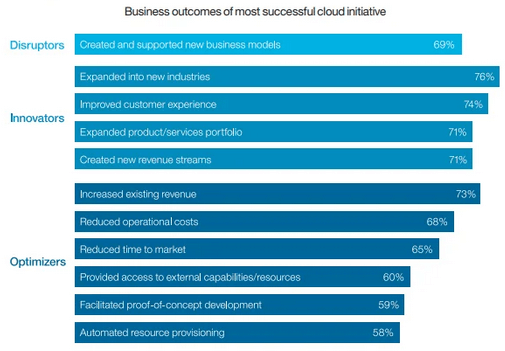Today’s business world is reverberating with the drumbeat of digital transformation. Organizations across industries sprint to keep pace with evolving customer demands, competition, and ever-shifting technological landscapes.
Adopting Amazon Web Services (AWS) has become a critical catalyst for success in this high-stakes race. IT infrastructure and applications in the cloud require a well-defined AWS cloud migration strategy, one that charts the path to maximizing the transformative power of this technology.
This blog serves as your compass, guiding you through the intricacies of AWS cloud migration and empowering you to start a successful course toward digital dominance.

Source: IBM
Cloud migration strategies and their importance
The decision to migrate to AWS is just the first step on your digital expedition. Choosing the right path is crucial, for it affects the pace, cost, and ultimately, the success of your cloud takeover.
But why migrate at all? Why abandon the familiar confines of your on-premises castle for the uncharted territory of the cloud? Consider these treasures that beckon from the cloud:
- Agility: Adapt and scale your applications quickly, just like a cloud expert avoiding digital challenges.
- Scalability: If you need more servers to manage high traffic, the cloud has plenty available, just a click away.
- Cost-efficiency: Ditch the expensive upkeep of on-premises infrastructure. The cloud offers a pay-as-you-go model, like renting a cloud-powered dragon instead of buying your own stable.
- Innovation: Embrace the latest cloud technologies and unlock new possibilities, like using a cloud-powered telescope to scan for future business opportunities.
With these riches within reach, who wouldn’t want to join the cloud migration craze? However, navigating the landscape of the seven Rs without understanding their strengths and limitations can lead to detours and missed opportunities. In the next section, we’ll delve deeper into each R, unpacking their individual characteristics and equipping you to chart the optimal course towards your cloud kingdom.
The seven R’s of cloud migration
The seven R’s represent distinct migration strategies with varying degrees of complexity, speed, and long-term impact on your application portfolio. Let’s explore each R in detail, highlighting its purpose, suitability, and potential limitations:

Source: AWS
1. Rehost (Lift and Shift): This rapid and cost-effective option involves directly migrating applications to the AWS cloud infrastructure without significant architectural changes. Think of it as simply relocating your servers to a cloud data center, leveraging its scalability and resilience. However, this approach may limit long-term agility and cloud-native optimization potential.
2. Relocate: If you seek specific AWS features or multi-cloud flexibility, relocating applications to a different cloud platform might be ideal. This approach requires careful planning and compatibility testing but opens doors to specialized services or cost optimization opportunities.
3. Replatform: When existing architecture impedes cloud optimization, replatforming applications allows you to fully utilize cloud-native principles. This approach involves significant reworking to unlock advanced scalability, elasticity, and resilience. However, it demands substantial resources, expertise, and planning.
4. Refactor: For applications where future-proof agility is crucial, refactoring involves building them completely from scratch, embracing serverless technologies and microservices architecture. This most comprehensive approach unlocks future potential but requires intensive resources and planning.
5. Repurchase: Instead of extensive replatforming, you can repurchase outdated applications for cost-effective cloud-native equivalents offering similar functionality. This approach streamlines maintenance, provides modern features, and leverages the inherent advantages of cloud architecture.
6. Retire: This AWS cloud migration strategy targets outdated, underutilized, or incompatible applications. Retiring these applications liberates resources and simplifies your IT infrastructure, while reducing maintenance costs and potential security vulnerabilities.
7. Retain: For stable and compliant applications, retaining them on-premises ensures operational continuity and minimizes disruption. This approach avoids unnecessary migration efforts and allows you to focus cloud resources on strategic priorities.
By understanding the strengths and limitations of each R, you can confidently choose the most appropriate migration strategy for each application in your portfolio. Remember, a hybrid approach is often optimal, tailoring specific R’s to different applications for successful cloud adoption.
When to use each migration model
| Migration strategy | Use Case | Benefits | Implementation |
| Retire | Outdated, underutilized, or incompatible applications |
|
Analyze workload dependencies and plan sunsetting process |
| Retain | Stable and compliant applications needing operational continuity |
|
Assess compliance requirements and optimize on-premises environment |
| Rehost (Lift & Shift) | Rapid and cost-effective migration with minimal architectural changes |
|
Refine infrastructure sizing and optimize resource utilization |
| Relocate | Specific cloud feature requirements or multi-cloud flexibility |
|
Evaluate target platform compatibility and plan data migration strategy |
| Repurchase | Cost-effective cloud-native alternatives for outdated applications |
|
Identify suitable SaaS or PaaS offerings and plan application integration |
| Replatform | Significant performance and agility gains, but with greater reworking |
|
Invest in development resources and plan application modernization roadmap |
| Refactor | Complete rebuild for future-proof agility and cloud-native optimization |
|
Secure dedicated resources and prioritize development expertise |









